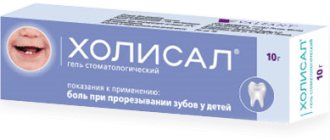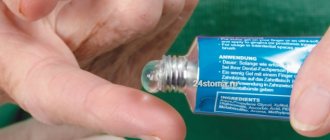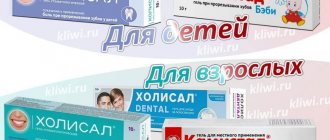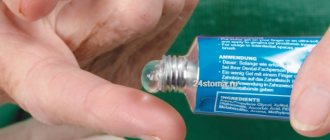From this article you will learn:
- Cholisal gel – reviews from dentists,
- its comparison with Metrogil-Denta, Holisal-Dental,
- how to use it for children,
- price for Cholisal, its cheap analogues.
The article was written by a dentist with more than 19 years of experience.
Cholisal gel is a dental preparation in the form of a gel that has antimicrobial, anti-inflammatory and analgesic effects. This medicine is intended for application to the oral mucosa, for example, for inflammation of the gums, stomatitis, teething, etc. The effectiveness of the drug is ensured by the presence of 2 active components - “choline salicylate” and “cetalkonium chloride”.
For the dental gel Cholisal - the instructions for use contain the only restriction that concerns the use of the drug in children under 1 year of age (with caution). The latter is due to the fact that the drug has an anise flavor, which can unnecessarily stimulate salivation in a child. It should be distinguished from the drug Cholisal - the drug “Cholisal DENTAL”, similar in name, which has a completely different composition and is intended only for the prevention of inflammation.
Gel Cholisal and Cholisal DENTAL –
Please note that there are 2 similar versions of Cholisal gel, both of which are produced (in Poland or Latvia). The first option is directly the dental gel CHOLISAL, which contains choline salicylate and cetalkonium chloride. But in pharmacies you can also find a second version of the drug - this is Cholisal DENTAL gel, which is not a drug and contains only 1 active component “aprotinin” (antioxidant). Therefore, Cholisal Dental gel is useful to us - only for courses of prevention of periodic exacerbations of gingivitis or periodontitis.
As the author of the article, I have more than 10 years of experience as a periodontist and, accordingly, the same experience in using Cholisal gel in my patients (state-issued documents on advanced training in the Periodontology program can be viewed in the editorial section). And I can responsibly declare that this is the best drug for treating gum inflammation, as well as for solving many other problems in the oral cavity.
Cholisal gum gel: indications for use
First of all, we will be interested in the usual Cholisal-gel, because... This is what we will use in courses of anti-inflammatory therapy for gum inflammation (gingivitis and periodontitis). This drug has a truly powerful anti-inflammatory effect, and this is what will be discussed in our article. This medication may be used in the following situations:
- in the treatment of gingivitis,
- in the treatment of periodontitis,
- with inflammation of the hood above the wisdom tooth,
- with inflammation of the mucous membrane under removable dentures,
- with stomatitis,
- during teething in children,
- for injuries to the mucous membrane (including when wearing braces).
Indications for Cholisal DENTAL gel –
Gel Cholisal Dental can be used only in the intervals between courses of anti-inflammatory therapy with Cholisal gel (as maintenance therapy). This gel has good antioxidant properties, which will not help us in any way in the treatment of acute or chronic gum inflammation.
Compound
To fully understand the effect of a medicine, you need to familiarize yourself with its constituent components. Thus, Holisal Dental includes:
- Chlorine salicylate;
- Cetalkonium chloride;
- Anise oil.
These are the main components, of course, other ingredients are also present in small quantities. The composition of Holisal Dental gel is slightly different from the previous one. It consists of:
- Propylene glycol;
- Propyl parahydroxybenzoate;
- Sodium hydroxide.
- And some other components.
Both options, also for children, are indicated for use in similar situations - in the presence of ulcers, inflammation and damaged areas on the surface of the oral mucosa.
Gel Cholisal – price, composition and analogues
Prices below are for 2022. For Cholisal gel, the price will be from 410 rubles for a tube of 10 g and from 480 rubles for 15 g. The cost of Cholisal DENTAL gum gel will be from 360 rubles in pharmacies (for a tube of 15 g).
For the drug Cholisal, patient reviews show that for a course of treatment of gingivitis lasting 7-8 days, you will need 1 tube weighing 15 g. And for a full 10-day course of treatment of chronic periodontitis (of course, if you are not going to save too much on the gel) - already You will need 2 tubes of at least 10 g each.
Cholisal: composition
Dental gel Cholisal has the following composition:
| The content of active substances in 1 g of gel is → choline salicylate (87.1 mg), → cetalkonium chloride (0.1 mg). |
| Auxiliary ingredients – hyaetellose, methyl parahydroxybenzoate, propyl parahydroxybenzoate, glycerol, anise seed oil, ethanol, water. |
→ Gel Cholisal instructions for use (official, PDF)
Composition analysis –
The active component “choline salicylate” is a derivative of salicylic acid. It has an anti-inflammatory effect due to the fact that it blocks inflammatory mediators in the inflamed mucous membrane and gums. It has the property of penetrating deeply into the mucous membrane, which is very important because... most other dental gels (containing antiseptics) act only on the surface of the mucous membrane.
The active component “cetalkonium chloride” is an antiseptic. It has a direct antimicrobial effect on pathogenic microorganisms (both gram-positive and gram-negative), and also has weak activity against some fungi and viruses. The big advantage of Cholisal is its combined composition, which allows it to act as both an antimicrobial and an anti-inflammatory agent.
Cholisal also has an analgesic effect, which begins to be felt approximately 2-3 minutes after applying the gel. At the same time, the duration of the analgesic effect is individual, and on average this effect can last in different patients - from 2 to 8 hours.
Cheap analogues -
Cholisal gel: analogues in pharmacies... a complete analogue of Cholisal gel is only the drug “Mundizal-gel”, and this drug is even more expensive, and its tube volume is only 8 g. There are no other direct analogues, however, there are indirect analogues. Let us recall that choline salicylate is a non-steroidal anti-inflammatory drug (NSAID), which belongs to salicylic acid derivatives. Other salicylic acid derivatives include methyl salicylate, phenyl salicylate.
Phenyl salicylate contains a dental gel called Parodontocide, and it also contains thymol, allantoin, essential oils of sage, mint, oregano and cloves (the cost of the gel is about 150 rubles per 15 ml). As a periodontist, I can say that this gel has a good anti-inflammatory effect, but insufficient antiseptic effect. Therefore, Parodontocid will certainly be weaker than Cholisal gel, but if, when treating gum inflammation, you combine it with antiseptic rinses with 0.2% chlorhexidine, then you will also get a good result.
Foreign analogues of Cholisal gel
A large number of dental gels are currently available in pharmacies. Imported analogues of Cholisal are quite popular, as they have a quick and long-lasting effect.
Metrogil Denta
A special feature of this medicine is that it is available in packages of various sizes - 5, 10 and 20 g. This is a combined bactericidal drug that has a wide range of applications. It is prescribed for the treatment of inflammatory diseases caused by viruses (herpes, enterovirus), yeast, anaerobic bacteria (treponema, neisseria, trichomonas, chlamydia, ureaplasma). For preventive purposes, Metrogyl Denta is used after dental procedures (tooth extraction, filling), after professional teeth cleaning.
Metrogil action spectrum
Active ingredients: chlorhexidine digluconate and metronidazole benzoate. Propylene glycol, water, sodium hydroxide, carbomers are used as a base, and sodium saccharinate and levomenthol, which also has cooling properties, are used to add flavor.
Contraindications:
- allergy to one or more components;
- age up to 6 years;
- period of pregnancy and lactation.
While using Metrogyl, skin rashes, itching, and headaches may occur.
The drug is intended for local use. The gel must be applied using a cotton swab and swab to the affected areas, spread evenly in a thin layer. Before use, hygiene procedures must be carried out. Usually the drug is used 2 times a day for a week.
Kamistad
The drug is available in the form of an oral gel. Used to treat inflammatory diseases of the gums, mucous membranes and soft tissues of the oral cavity, which are accompanied by pain, swelling and the appearance of wounds and ulcers.
Active substances:
- Lidocaine is a local anesthetic of the amide series. Blocks the conduction of nerve impulses in the central nervous system, stabilizes cell membranes.
- Thymol is a phenol derivative with pronounced fungicidal and antiviral properties.
- Chamomile flower extract is a complex of biologically active substances that eliminate redness, swelling, normalize blood circulation and metabolism in the affected area.
According to the instructions, a 0.5 cm strip of gel is enough for a one-time application. It can be rubbed into the affected surface or used as an application. The drug is not absorbed into the bloodstream, however, you should not apply the gel too often or in large quantities. The most common adverse reaction is a burning sensation and itching. In rare cases, allergies may develop - rash, urticaria, Quincke's edema or anaphylactic shock. The drug has no age restrictions.
Oral gel Kamistad-N is also available for sale. Its composition does not contain thymol, and formic acid, cinnamon oil, and ethanol are used as auxiliary components. This form is prohibited for use in children under 12 years of age and in women during pregnancy and breastfeeding.
Sold in tubes of 10 g without a doctor's prescription. Manufacturer: German.
Pansoral
Pain relieving oral gel on a natural basis. Used in infants after 3 months to eliminate unpleasant symptoms - itching, pain, swelling, excess salivation. Indications for its use include mechanical damage to soft tissues, stomatitis, gingivitis, and increased bleeding.
Description of the drug
The antibacterial and analgesic effect of the drug is due to the complex interaction of plant components:
- Roman chamomile – reduces signs of inflammation, improves gum nutrition;
- mallow (marshmallow) – creates a protective film on the surface of the gums, increases tissue permeability;
- seed saffron – kills pathogens, strengthens capillaries;
- Irish moss – prevents the development of allergic reactions, has astringent properties.
The drug does not contain flavorings, dyes or sugars. Glycerin and carbomers are used as a base.
A small amount of gel is applied topically with a soft swab or cotton swab 2-3 times a day in between feedings. Since Pansoral is used as symptomatic therapy, the duration of treatment is selected individually.
See also:
Cheap analogs of Venolife gel and reviews about it
Gel Cholisal - patient reviews
Reviews of Cholisal gel from patients and specialists are usually only positive. But! As a periodontist, patients periodically came to me to self-medicate their gums, including with the drug Cholisal. And when, after removing dental plaque, I recommended Cholisal to them (as part of a course of anti-inflammatory therapy), some of the patients said that this was a bad, too expensive and ineffective drug.
The reason for the bad reviews in this case is solely due to errors in the use of the drug. The fact is that, faced with another exacerbation of gum inflammation, patients forget that the reason for this is soft microbial plaque + tartar. If you start using the drug without first removing plaque, the effectiveness of the gel will be significantly lower, and the effect itself will not last long (24stoma.ru).
Therefore, if you want to get truly truly effective therapy, before using Cholisal gel you need to make an appointment with a periodontist for ultrasonic teeth cleaning. After removing dental plaque, the doctor will prescribe you a course of anti-inflammatory therapy (consisting of antiseptic rinses and gel applications on the gums), which you can carry out independently, using the doctor’s recommendations.
Advantages of the drug Cholisal -
- very good anti-inflammatory/antimicrobial activity,
- relieves pain well and quickly,
- the gel adheres well to the mucous membrane,
- the active components of Cholisal act not only on the surface of the mucous membrane, but also penetrate well into the inflamed tissues.
Disadvantages of the drug -
- high price,
- has the taste and smell of anise, which leads to an increase in salivation (in adults this is not critical, but in infants it can cause numerous inconveniences - drooling from the mouth, irritation of the skin around the mouth, and you definitely need to monitor the baby to avoid choking on saliva) .
Properties and composition
Dental gel is a homogeneous transparent mass to which no dyes are added. The basis of the solution is oil produced from anise seeds, which gives the product a certain specific smell.
The composition includes several active components, namely:
- citalkonium chloride, which is an effective antiseptic substance that can have a detrimental effect not only on pathogenic bacteria and fungal microorganisms, but also on viruses;
- choline salicylate, capable of penetrating into tissues, providing not only an antipyretic, analgesic and anti-inflammatory effect, but destroying both fungal life forms and microbes, stopping the activity of microorganisms living in acidic and alkaline environments,
allowed pharmacists to create a drug that promotes the complex treatment of common dental diseases.
How to apply Cholisal for gum inflammation -
For Cholisal gel, the instructions for use published by the manufacturer will not tell you exactly how to apply the gel to the gums. Please note that Cholisal gel for gingivitis and periodontitis should be used only as part of complex therapy, which will include antiseptic rinses, applications of the gel to the gums, and, if necessary, also the use of special anti-inflammatory toothpastes for bleeding gums.
ANTI-INFLAMMATORY THERAPY SCHEME:
The course is prescribed by a dentist, but in any case you must do it yourself, using the doctor’s recommendations. The standard course of treatment for gingivitis will be 7-8 days, periodontitis – 10 days. Procedures are carried out 2 times a day - morning and evening. First you should have breakfast and after that brush your teeth (it is important to eat first, and only after that brush your teeth, and not vice versa). And only after this, rinse the mouth with an antiseptic and apply the gel to the gums. In the evening it is the same - procedures are carried out only after dinner and oral hygiene.
So, after you have brushed your teeth, you will first need to rinse your mouth with an antiseptic chlorhexidine. To do this, you must take about 10 ml of solution into your mouth (this is about 1 sip) and then, without spitting, rinse your mouth for 1 minute. After rinsing, do not rinse your mouth with water! An important issue is the concentration of the chlorhexidine solution. For periodontitis, only 0.2% chlorhexidine should be used, but for gingivitis in adults, a 0.12% concentration may be sufficient. Chlorhexidine 0.05% can be fully effective only for gingivitis in children and adolescents (you can read why this is so in the article on chlorhexidine at the link above).
Applying Cholisal gel to the gums - immediately after rinsing your mouth with an antiseptic, you should apply the gel to the gums. An important point - before applying the gel, it is advisable to dry the gums with a dry gauze pad, making it out of a bandage. The fact is that any dental gels are better fixed on the dried mucous membrane, and if the mucous membrane is excessively wet, this will worsen the fixation of the gel on the mucous membrane of the gums.
You need to apply Cholisal gel to the gums in front of a mirror, and you should bare your teeth properly to see the gingival margin (i.e., where exactly you will apply the gel). The gel should be squeezed onto the pad of the index finger, and then the gel should be transferred to the gums - first around the lower, and then around the upper teeth. Please note that the gel should be applied only to the very edge of the gums, which is directly adjacent to the necks of the teeth. The main emphasis when performing gel applications is done from the front surface of the dentition.
It is better to do the treatment of gums on the front surface of the teeth in two stages. First, by squeezing a little gel onto your finger, you should rub the gel into the gum margin with light massaging movements. Then squeeze the gel onto your finger again and apply it to the gum edge without massaging. On the tongue/palate side, you can treat by rubbing a small amount of gel (without a second step).
→ The best rinses for gum inflammation
Important: keep in mind that when applying the gel, saliva will be released, but it does not need to be accumulated in the mouth or specifically spit out. You must swallow it - as you usually do. In addition, after applying the Cholisal gel to the gums, it is advisable not to drink for about 30-60 minutes, but most importantly, do not eat or rinse the mouth for 2-3 hours. The second treatment is carried out in the evening according to a similar scheme (dinner → then brushing teeth → then antiseptic rinse → then applying gel). And so on for 7-10 days.
Cholisal: application and principle of action
The gel form used in the treatment of dental diseases allows for complex treatment of the oral cavity, since the active substances of the drug are capable of:
- block inflammatory mediators in soft tissues;
- effectively suppress the activity of pathogenic microflora;
- anesthetize affected tissue areas.
Therefore, experts recommend Cholisal as one of the most effective means to eliminate several consequences of diseases.
In addition, the effectiveness of the composition can be enhanced by prescribing the use of the drug in conjunction with prescribed rinsing procedures with active antiseptics, for example, chlorhexidine.
In addition to its excellent healing properties, the use of the gel helps to provide:
- prolonged effect of the drug on the mucous membranes;
- high efficiency in eliminating inflammatory phenomena;
- relief of painful sensations, which is facilitated by the rather viscous consistency of the composition, which helps the active substances to be quickly absorbed into the affected tissues, fighting foci of inflammation.
However, Cholisal, the price of which is quite high, cannot be used without appropriate doctor’s recommendations.
Cholisal gel, the instructions for use of which include purchasing the medicine without a prescription, can be successfully used to treat diseases in people of any age, but the smell and taste of anise oil can cause excessive salivation, therefore Cholisal is not recommended for use in infants.
Cholisal gel: instructions for use and indications for use
The antimicrobial, anti-inflammatory and analgesic effectiveness of the drug allows specialists to successfully use the drug in the treatment of such oral diseases as:
- gingivitis;
- periodontitis;
- inflammation during the eruption of wisdom teeth;
- inflammation of the mucous membranes as a result of wearing dentures;
- traumatic injuries to the oral mucosa;
- stomatitis,
It also helps reduce pain when molars appear in children.
For gingivitis and periodontitis
Based on the instructions for use of the drug, experts recommend using the gel in combination with other medicinal formulations and therapeutic measures.
So, when gingivitis or periodontitis is detected, in addition to cholisal, the following is usually prescribed:
- removal of deposits;
- antiseptic rinsing procedures;
- using special cleaning pastes to reduce inflammation;
and in severe cases of the disease - antibacterial therapy.
Self-medication, which involves using only a gel composition, will not help complete recovery from the disease, but the disease can take a chronic form, which can cause tooth loss.
The course of treatment with Cholisal gel prescribed by the dentist is carried out for ten days. Applications are carried out twice a day, usually in the morning and evening hours, after eating, since the procedure requires:
- thorough brushing of teeth;
- mouth rinses with antiseptic agents;
- drying the mucous surfaces of the gums
and only after this, apply the gel to the areas of inflammation.
The composition is applied both to the front and back walls of the gums, located on the side of the tongue, and such treatment requires avoiding the use of liquid for half an hour after the end of the procedure.
Some ingredients of the gel help increase salivation, so saliva should be swallowed without much fear, since the drug causes virtually no side effects.
How to use Cholisal for stomatitis -
It makes sense to use Cholisal for stomatitis mainly only to reduce the pain of erosions. For example, the cause of herpetic stomatitis is the herpes virus types 1-2. Cholisal gel does not have clinical effectiveness against the herpes virus (here it is better to use Miramistin for rinsing the mouth), but it does a good job of anesthetizing erosions and ulcerations on the mucous membrane.
What do different forms of stomatitis look like?
As for the use of the drug Cholisal for aphthous stomatitis, in this case its use is even more justified, and not only for anesthesia of erosions on the oral mucosa. Among the reasons for the development of aphthous stomatitis, one can highlight not only allergic reactions, but also a complex autoimmune mechanism in which the streptococcus Streptococcus sangui is involved. Thus, the effectiveness of Cholisal for aphthous stomatitis may be associated, among other things, with the antimicrobial effect of this drug.
Reviews of Holisal Dental
As already mentioned in the article, there are several types of medications. There are no particular differences among them. The only difference is the price. The good old version of Cholisal costs at least 350 rubles. The tube contains 10 g of substance. In that case, the price of Holisal Dental gel for 15 grams is no more than 200 rubles. The fact is that the manufacturer has updated the product and significantly reduced the cost. The old options remained with a fixed price.
Reviews about Holisal Dental gel and its variants are only positive. Parents of teething children are especially enthusiastic. Thanks to the products, they become much calmer, sleep and eat well.
Cholisal gel for children during teething –
Now, regarding reviews of Cholisal gel for children. For example, this drug is perfect for treating gingivitis in children and adolescents. As for teething, the drug will also have a good analgesic effect (in this situation, the drug is already used 3-4 times a day). In this case, the mucous membrane in the area of the erupting tooth must first be dried with a dry gauze swab, and then successively rub 2 small portions of the drug into this area.
Rub the drug into the mucous membrane with a clean finger, using light massaging movements. If you simply apply the drug to the mucous membrane (without massage), the analgesic effect will be less lasting. The duration of pain relief after applying Cholisal gel varies individually and can range from 2 to 8 hours. Cholisal should be used with caution when teething in infants (children under 1 year).
Due to the content of anise oil, the drug can unnecessarily stimulate salivation. This will lead to the fact that the baby may choke on saliva (and therefore also cough), and drooling from the mouth may also occur. To prevent this as much as possible, it is better in this case to use Cholisal only after feeding and subsequent oral hygiene of the child. Moreover, the drug should not just be applied to the mucous membrane, but, as we said above, it should be rubbed into the dried mucous membrane.
→ Alternative gels for teething → Drugs for relieving anxiety during teething
Possible unwanted effects
The instructions prescribe using the drug with caution during pregnancy and breastfeeding, that is, the product must be recommended by a specialist, which involves monitoring its use and abandoning the gel, if necessary.
Thus, domestic medicine does not prescribe treatment with Cholisal gel during the first trimester of pregnancy.
Complications and negative consequences when using Cholisal gel were observed by practicing doctors extremely rarely. However, increased individual sensitivity to the ingredients of the drug can manifest itself as:
- not a strong burning sensation in the areas where the product was applied;
- redness;
- itching
These side effects most often disappear within a few minutes.
However, when the first unwanted symptoms appear, experts recommend stopping using the gel, since the cause of an allergic reaction may be:
- salicylates;
- anise oil,
as well as other ingredients included in the product.
In addition, dentists advise using the optimal amount of the drug during procedures, avoiding overdose.
In addition, it should be taken into account that the use of cholisal with other analgesics, anti-inflammatory drugs, antipyretic syrups can increase the concentration of active substances in the body, and an excess of antibiotics and antiseptics can also cause an allergic reaction.
Considering the free sale of Cholisal gel in pharmacies, before purchasing and using the drug, you should consult with a specialist, which will allow you to use the modern combined action product most effectively.
Holisal Dental or Holisal: which is better?
To the question: which is better than Holisal DENTAL or CHOLISAL - we have already answered at the beginning of this article.
Let us repeat that Cholisal DENTAL gel is not intended for the treatment of acute or chronic inflammation of the gums, nor for the treatment of stomatitis, nor for anesthesia of the mucous membrane. This drug has only antioxidant properties (i.e., it reduces vascular permeability, thereby reducing swelling and bleeding of the gums, and can also increase local immunity of the oral mucosa). Composition of the gel Cholisal DENTAL –
Therefore, CHOLISAL gum gel is certainly stronger and more effective. As for the drug Cholisal DENTAL (instructions), it is no longer registered as a medicine. But you can use it to prevent exacerbation of gingivitis or periodontitis - between periodic courses of using regular Cholisal gel (so to speak - as maintenance therapy). Application regimen: 2-4 times a day, immediately after oral hygiene.
What is the difference between Holisal and Holisal Dental
Many people do not pay attention to one additional word in the name of the drug. How exactly Cholisal differs from Cholisal Dental can be determined by comparing the indications for use and the composition of these two medicines. The presence of the word Dental determines the specific focus of one of the types of medications. Dental means dental, that is, for the oral cavity. However, if you compare the insert papers from the two medications, there are practically no differences from each other.
It should be noted that there is also Holisal Dental for children. Although the other two types of medicine are allowed to be used by children over one year old, during the eruption of the first teeth at the age of six to eight months, it is advisable to use the children's version.
Holisal or Metrogyl Denta: which is better?
Metrogyl denta contains the antiseptic chlorhexidine 0.05% and the antibiotic metronidazole 1.0%.
This is the very first drug for the treatment of gum inflammation, which appeared in our country about 30 years ago. Its cheaper complete analogues are the drugs Dentamet gel and ASEPTA gum balm. Both components of the drug (chlorhexidine and metronidazole) have only an antimicrobial effect and do not have a direct anti-inflammatory effect. Dental gel “MetrogilDenta” –
The concentration of chlorhexidine in MetrogylDenta is very low, and it is more suitable - either for children and adolescents, or for the treatment of gingivitis in adults. The latter is due to the fact that for the treatment of periodontitis in adults, higher concentrations of chlorhexidine will be optimal - in gels for gums it should already be from 0.2 to 0.5%. Although, on the other hand, you can compensate for the lack of chlorhexidine concentration in MetrogilDenta by preliminary antiseptic rinsing with a 0.2% chlorhexidine solution, after which you can apply the gel.
But in fact, such a combination makes little practical sense, because 0.2% chlorhexidine already has a pronounced antiseptic (antimicrobial) effect. In addition, all the components of MetrogilDent also have only an antimicrobial effect, and it turns out that when prescribing these drugs, we do not use anti-inflammatory components at all. In addition, local use of antibiotics in the oral cavity is undesirable and even harmful, because this leads to the formation of resistant strains of bacteria, which become even more pathogenic to the gums.
Therefore, the optimal combination for treating gums is an antiseptic mouth rinse with 0.2% chlorhexidine and Cholisal dental gel, because the latter has not only an antimicrobial, but also an anti-inflammatory effect due to the content of choline salicylate. I hope that our answer to the question: Which is better, Cholisal or Metrogyl Denta, was clear to you.
Cheap analogues of Cholisal gel -
We have already said above that the price for Cholisal gel is from 470 rubles (per tube of 15 g), which makes this drug not very accessible to the general population, given that the consumption of the drug for a course of treatment can be 2 tubes. Therefore, below we will talk about a drug that, in its action, can be considered a relative analogue of Cholisal. We are talking about the gel “PERIODONTOCIDE”.
Let us remind you that Cholisal contains a salicylic acid derivative such as choline salicylate. In turn, Parodontocid gel contains a substance from the same group – phenyl salicylate. And below you can find out more about this drug.









